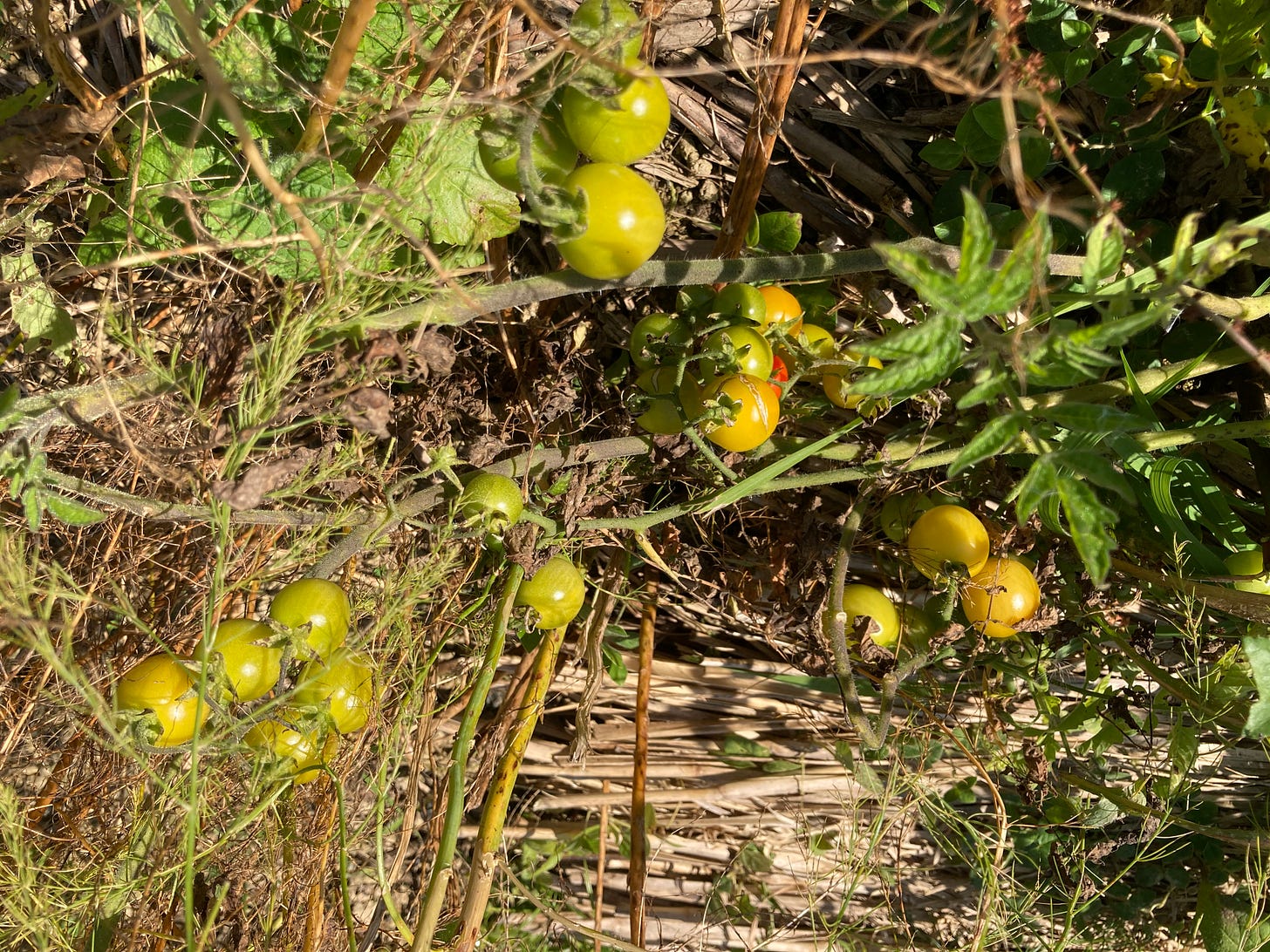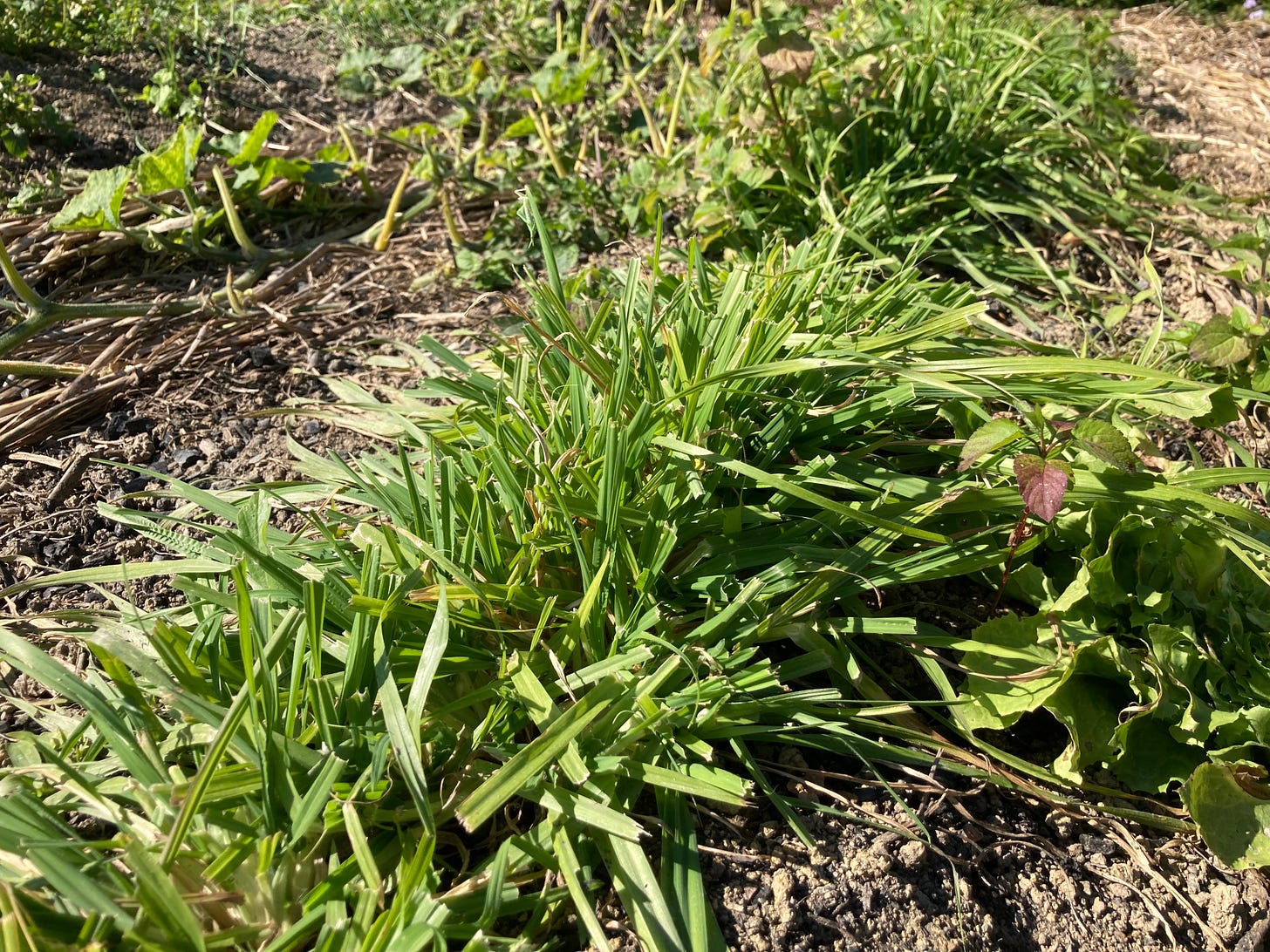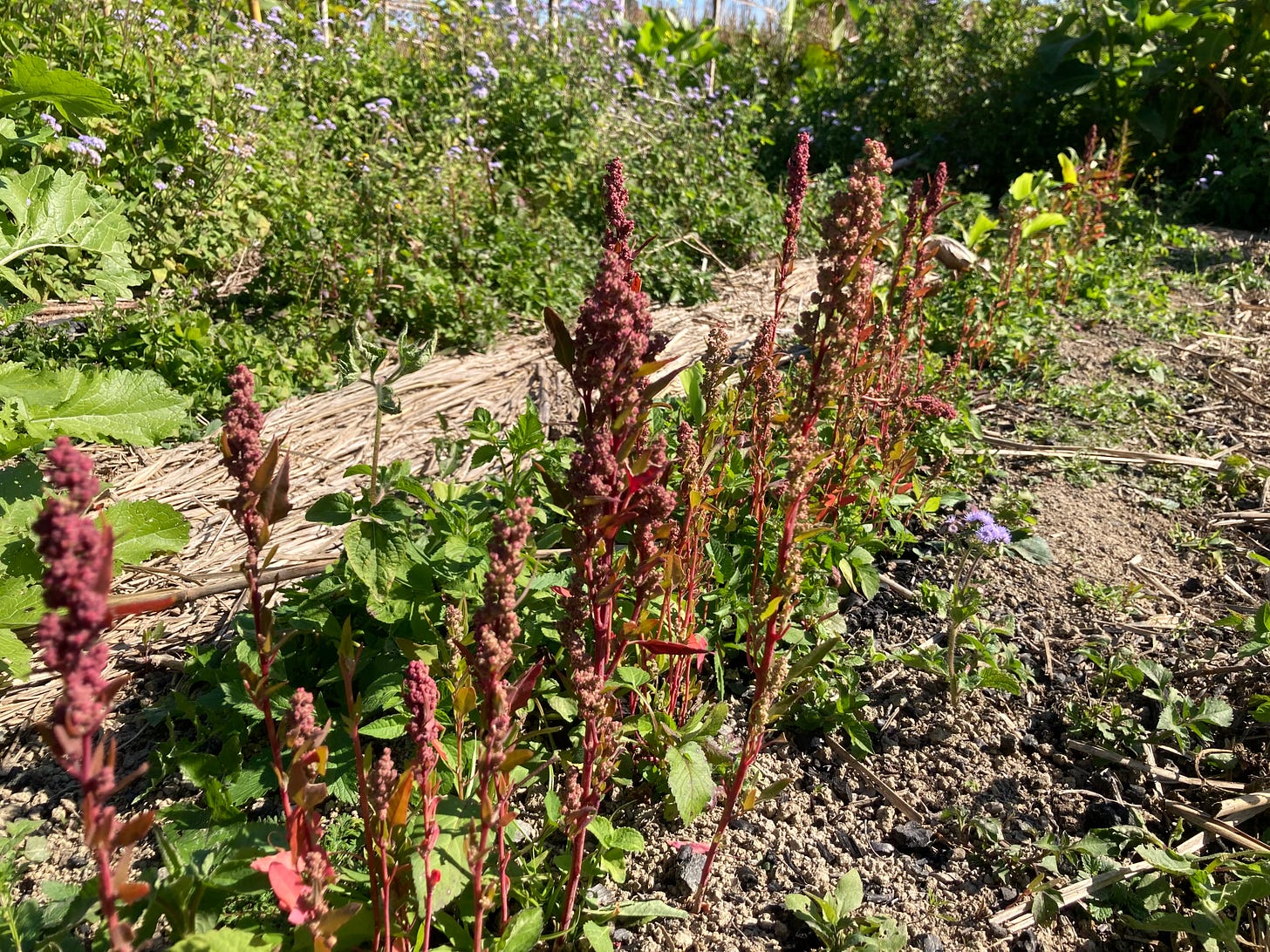Thank you for all the lovely suggestions and comments about the next book to review. I think Sheldrake’s “A New Science of Life” will be next to avoid too many economics type books in a row.
It feels like time for a quick wrap up post to let you know how things are progressing, and there is quite a bit despite my growing list of family commitments caring for my elderly parents. Mum is resting well and having the occasional brighter moment which gives us hope she will recover some of her lost capacity in coming months.
The F2 hybrid Tulbaghias are settling in nicely. I scattered old mustard seed over the beds and they provided a nice bonus of flower shoot greens, but when they got too far along to pick I simply sickled them all back. Annuals like this rarely regrow when shocked after they start setting pods. Their shade likely slowed down the establishment of other weeds, giving me more time to do a light hand weeding around the tiny establishing Tulbaghia seedlings.
So far I only got one bed of F2 Ethiopian kale started, on top of the recent watermelon patch. I mounded the beds up higher than usual, creating an alternating pattern of old cucurbit mounds and fresher, heavier path soil. The kales seem to prefer the latter. I didn’t top dress with manure, and I sowed quite thickly since I wasn’t sure how viable the seed was, so the plants are fairly compact and not super luxuriant, but I didn’t plant them for production. Instead, I am getting a lovely range of variation in their tendency to bolt to seed. Some barely get established then try to flower. These are being steadily harvested for more fresh flower top greens, but I pull the roots of these fast-maturing seedlings as I pick. I should have no trouble ending up with a dozen of the slowest flowering plants, though I hope to nibble some of their young leaves to check they all taste nice before making the final selection. My triticale and teff beds didn’t germinate, so in the next few weeks I will sow more Ethiopian kale F2 in them and repeat the process. If the timing lines up I might back cross to pure slow/tall Ethiopian kale since I have a couple of self-sown seedlings that shouldn’t flower until well into spring.
The F2 hybrid tomatoes have been interesting. I got a couple dozen seedlings started from direct sowing in beds I mounded, manured and charcoaled. I planned to give them a follow up hoeing to reduce the weed pressure but that never happened, but I figure that is an interesting selective pressure. The simple models I read about with determinate bush shape growth form being a simple recessive trait proved incorrect. No plants are as sprawling as the wild pimpinellifolium, but likewise none are quite as compact as Principe Borghese. As a result I have pivoted to selecting seed based on fruit quality- any with thick walls get added to the F3 generation. I plan to back cross to Principe Borghese and see if that restores the growth habit I prefer.
I have good and bad news about the jobs tear trial. The plants have grown beautifully through the damp winter. Lovely luxurious growth and huge panicles of fat grains. Despite their heavy seed coats they have proven no match to our local birds, and a steady pile of husks is building up under each clump. Macadamia nuts, with their thick shells, make sense in light of our local birds. The upside is that nothing seems to eat Lomandra seeds as they ripen, so domesticating that new crop looks like it might have potential.
Somehow in between the rain and other distractions I got around 300 seedling icecream bean trees planted. About 250 went around the periphery of the goat paddock boundary electric fences in grassy spots, so they can shade out the undergrowth and make clearing the lines easier (plus provide bonus branches during droughts). It has been so long since things properly dried out it almost feels like drought is a legend like sasquatch. The last 50 went in as the first row in the second Inga alley system. That means next year I will be repeating the process with around another 200 trees to fill out all the rows.
One fun observation- the bed of rescue grass (Bromus catharticus) I planted (the first time I ever sowed it deliberately) came up beautifully but then attracted the attention of the local herbivores. This is noteworthy since this species is getting minimal impact in the various places it has germinated spontaneously. I suspect this is another example of higher nutrient levels (the sowed bed got goat manure, with all its associated minerals) being more important than the species name on the label. I will continue exploring if I can use this species in any way as an edible. It has a pretty solid indigenous history as a seasonal staple in south America and grows as an abundant winter grass here in subtropical Australia. I just have to remember not to treat it too generously.
A small test planting of mixed quinoa and huauzontle varieties from the variety trials last year has also been interesting. Neither crop has gotten over 30 cm tall, but they got off to a horrible drowned and muddy start. Since I have had 1.5 m tall huauzontle in previous nicer years maybe there is hope I can one day get decent quinoa crops as well. Hand crossing these is still on my to do list, but I probably missed my window of opportunity this year due to the incessant autumn rain. I have a big bowl of Celosia seed in the kitchen waiting for me to try preparing and eating it, and the vigour of this species under my conditions is a hundred times my happiest Chenopodiums. Time will tell which of them works better.
The vegetable garden is looking a bit rough, with annual weeds sprouting in various places where the crops didn’t take off (such as the winter pumpkin variety trial which was a complete bust). Things move more slowly in the winter, so I have a week or two more to get in and sickle them hard to avoid a big bump in the weed seed population.
To make life interesting, my teenage goat buck (Kevin) managed to slip through the boundary fence just as I was preparing to take my elderly mother to a medical appointment. Luckily he is a sweetheart, so I just had to calm him down, grab him by the horns, and ride him like a tricycle back to an old dog gate in the barbed wire and dog wire fence then push him through like it was a dirty laundry chute. The electric fence has been off for weeks due to a hidden short circuit. I locked the whole herd away until after the appointment, then quickly ran another electric tape line down that boundary to stop him getting in the habit of escaping. The fence is still off for now until I can spend a whole morning hunting for the short circuit. The goats seem happy enough browsing the whole 10 acre paddock without often reaching the edges- they will never catch up with the growth. Some establishing icecream beans have been hit hard and may die under the pressure. I’m just grateful the Kevin wasn’t in rut or I would have reeked of goat in the waiting room.
So that is a snapshot of my world. Many challenges await on the horizon, but for now I am enjoying the cool weather and overflowing greenery and taking things one day at a time.













